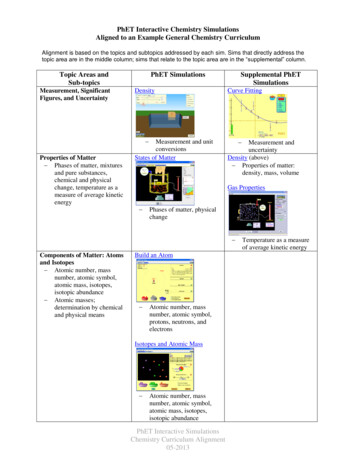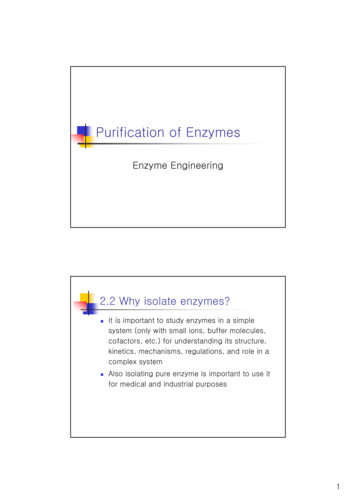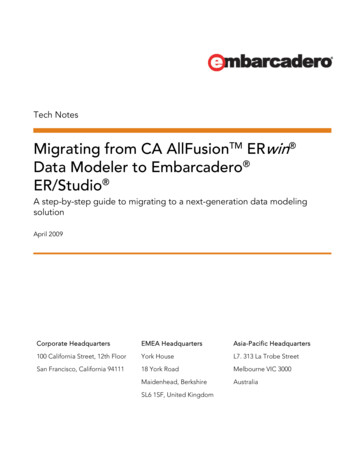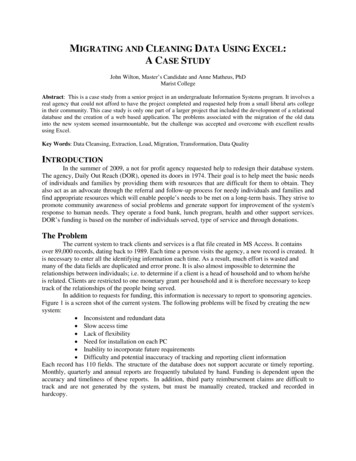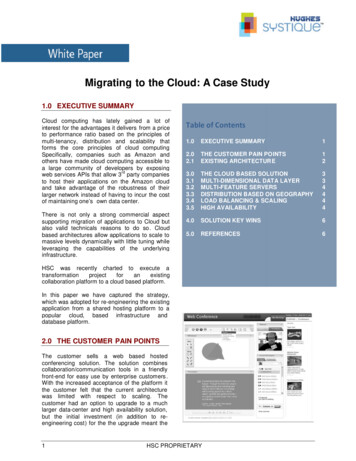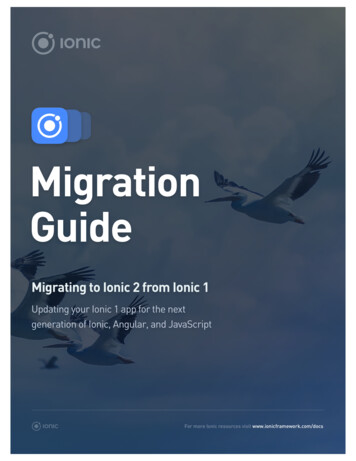
Transcription
Migrating to Ionic 2 from Ionic 1IntroductionIonic 2, the next version of the popular Ionic Framework, has been in development since early2015. The Ionic team has been working closely with the Angular team on Ionic and Angular 2,focused on the major effort to build the next generation of Angular using new JavaScript andWeb technology standards. With a rare opportunity to rethink how a mobile app frameworkshould work with the next generation of JavaScript, Ionic 2 quickly became an ambitious effortto take all the lessons learned from Ionic 1 and build the best framework for the future of mobileapps.Today, many people still use Ionic 1 and Angular 1, by most measures two wonderfulframeworks. However, there has been a massive ecosystem shift in the JavaScript worldtowards ES6 and TypeScript, along with embracing new technologies like Web Components.Angular 2 and Ionic 2 were built to carry web developers into the future of JavaScript.We’re incredibly proud of Ionic 2 and the many innovations and improvements that have goneinto it. However, we know that upgrading and migrating any code base is a daunting task. Wehope this migration guide makes the upgrade process less daunting, and encourages your teamto embrace the exciting trends in mobile app development that Ionic 2 is well positioned to takeadvantage of.Why Upgrade from Ionic 1 to Ionic 2?Many developers using Ionic 1 ask: “Why should I upgrade? Ionic 1 and Angular 1 work just finefor me.” Our answer to that is to please use the version that works best for you. Nothing makesus happier than to hear you are successful with any version of Ionic.However, there are some specific reasons developers might wish to upgrade to Ionic 2:Improved PerformancePerformance is an important consideration for any mobile app, Ionic or otherwise. Ionic 2 bringsa number of important performance improvements you should keep in mind.To start, Angular 2 is a faster framework than Angular 1 in a few important ways. First, change
detection uses a dramatically more efficient system where changes are isolated to components,and changes are uni-directional compared to the cyclic nature of Angular 2. This means nomore infinite digest loops, and changes in one component that result in the entire componenttree updating. It also means we avoid the treacherous two-way-binding that often ruined Angular1 app performance.(Angular 2 performance compared for large list rendering. Image credit)Additionally, Angular 2.0.0 brings a new pre-compilation called the Ahead-of-Time Compilersystem that packs templates into a hyper-efficient format, resulting in near-instantaneoustemplate rendering that doesn’t require expensive parsing or network requests.Beyond Angular 2 being faster, Ionic 2 has been rebuilt from the ground up for performance.Every component makes use of new APIs like requestAnimationFrame for 60 FPS animations,will-change properties for browser rendering optimization, and enhanced support for high-
performance native scrolling. Additionally, every component is audited for render, paint andCPU usage performance and rigorously tested.More ComponentsBy our count, Ionic 1 has 15 core components. By comparison, Ionic 2 has nearly thirty highquality and well tested components, as well as countless additional APIs and features.Some major new components include the all new Navigation component that makes it possibleto navigate and link to any page in your app from anywhere, as well as flexibility in presentingpages as modal windows, or using the standard transition.Additionally, Ionic 2 comes with powerful new Form controls that work both natively and on theweb, innovating on the stock form controls we’ve come to know as web developers. One greatexample of this is the all new Date Time picker.Beyond core components, Ionic sports stronger theming capabilities and support for new nativeAPIs like Taptic on iOS.Native Support and Storage UtilitiesIonic 2 comes with a powerful set of Native APIs for accessing any native feature your appneeds, such as Bluetooth, Health Kit, Touch ID, Fingerprint Auth, Camera, and a whole lotmore.Additionally, Ionic 2 comes with a flexible key-value Storage system that works on top of SQLite,IndexedDB, Local Storage, and other engines so you don’t need to worry about the nuances ofthe underlying storage engine. The Storage system exposes a simple key-value API making iteasy to store structured JSON data for building offline apps.Support for Progressive Web AppsProgressive Web Apps (PWAs) are a new paradigm shift in mobile app development, bringingall new APIs to mobile browsers to meet users where they are with improved mobileexperiences and capabilities. An effort largely started by Google, PWAs aim to reduce thefriction for mobile experiences, especially for users coming from Google Search and web links.Instead of pushing users to download a mobile app, businesses can now provide a traditionalapp experience immediately to mobile web and Google Search users, with many of the featureswe expect from apps: installing to home screen, push notifications, offline support, and more.With Progressive Web App support in Ionic 2, an Ionic developer can deploy a mobile app to theapp stores and the mobile web with the exact same code. This is important because users are
coming from many different places today, and businesses can no longer afford to lose mobileweb traffic through download interstitials and ads that Google says can result in nearly 69%page abandonment rates. It also means Ionic developers are now even more cross-platformthan their counterparts: one app runs natively and on the web with no changes! Talk aboutefficiency.For further reading on PWAs, we have a number of blog posts that dive deeper into this bravenew world, starting with our What are Progressive Web Apps? post.Modern JavascriptAnother great reason to migrate to Ionic 2 from Ionic 1 is to convert your ES5 Angular 1JavaScript into modern, standards-compliant ES2015/TypeScript. Considering the JavaScriptecosystem is embracing ES2015 and TypeScript, your code will benefit from the change andyour team will be able to work more effectively with the rest of the JavaScript ecosystem.Additionally, Angular 1 required many custom operations and concepts that have standardscomplaint analogs in ES2015/TypeScript. This includes scope which has been replaced withClass instance data, ng modules which have been replaced with ES2015 modules, serviceswhich have been replaced with vanilla classes, and many more.In particular, enterprise teams will find TypeScript to be a boon to the maintainability andstability of their code, with its powerful type system and advanced IDE features available.Quickly: Angular 2 vs Angular 1This migration guide is not a proper introduction to Angular 2 or TypeScript/ES6. For that, werecommend the myriad Angular 2 tutorials available online, starting with the official Angular 2Quickstart. The Ionic team also maintains a simple introduction to some of the core concepts inAngular 2 and ES6/TypeScript. Additionally, if you’d like to try TypeScript in an existing v1project to familiarize yourself, we have an introductory blog series on the topic.Generally, we find that developers familiar with the concepts in Angular from doing Angular 1development are able to pick up Angular 2 quickly, as the concepts underneath are very similar.As we like to say: it’s Angular all the way down.As you convert Angular 1 code to Angular 2, here’s a quick guide for mapping the old conceptsto the new ones: Angular’s custom functions for run/config/controller/directive/service have been replacedwith standard ES6 and TypeScript classes or methods. scope is now just class
instance data. There’s no more digest as Angular uses zone.js to automatically updatecomponents when instance data changes (it feels a bit like magic!)Angular directive usage in templates, such as ng-repeat and ng-if, now use the syntax*ngFor, *ngIf, respectfully. Other directives that dynamically set attributes, such as ngclass and ng-src, now use the dynamic attribute syntax, such as [class] ”” and [src] ””.Events now use the (eventName) syntax, such as (click) ”onClick( event)”.Custom directives no longer use the custom bind syntax, instead using @Input and@Output directives on class data to indicate properties that can be bound to.This is hardly an exhaustive list but should help you mentally map many of the most commonfeatures of Angular 1 to 2. The next step for learning Angular 2 concepts and how they map toAngular 1 is by reading the official Angular 1.x Upgrade guide.Step 0: Before We Jump InThis document walks through migrating an existing Ionic v1 app to v2. Follow along step-bystep, or explore the two projects side by side on github. The repos for the final v1 app and themigrated v2 app can be found here:V1: 1V2: 2The process for migrating an Ionic 1 app to an Ionic 2 app involves a few specific operationswe’ll either do once, or repeatedly. Here’s an outline of what we’re about to do:1.2.3.4.5.6.7.Start a new Ionic 2 app from scratchConvert our main app structure (i.e. tabs/menu/etc.)Update our themeConvert each Ionic 1 view/controller to an Ionic 2 Page, including porting our templatesConvert each Ionic 1 service/factory to an Ionic 2 ProviderConvert custom Angular 1 code to standards-compliant ES6/TypeScriptUpdate routes to use new navigation and deeplinksThere may be a few tasks you need to do that are unique to your app, but generally speakingthis is the process we will take and, chances are, you’ll be pleasantly surprised howstraightforward moving from Ionic 1 to Ionic 2 is.For this migration guide, we are going to use an Ionic app that renders a simple social network,called Ion Friends:
(Ion Friends is a simple social network app with a tabbed layout)Throughout the document, we will be showing code snippets for both our v1 apps and our v2app, and will denote each with these labels. The Ionic 1 label refers to our existing v1 app, andthe Ionic 2 label refers to the new one we are porting over to.Additionally, we will use monospace font to refer to commands that should be typed into acommand prompt.Finally, please keep in mind that we won’t be porting all the features over for the sake of thisexample, but will teach the migration concepts you can use to apply to your app.
Step 1: Create a new Ionic 2 AppWhile it’s possible to update an Ionic 1 app in-place, we recommend starting a fresh app tomake sure you have the proper files required for building apps and to avoid perplexing buildissues with two Ionic versions. Once your app works in the new Ionic 2 shell, it can be movedback to your existing app repo to replace your existing code.To speed things up, if your app uses tabs or menu, you can create a new starter app that hasthat layout by default. If your app is custom, you can start with a blank layout and build it fromscratch.To start, let’s install Ionic (or make sure you are using the latest version of the Ionic CLI), createa new app, and start an ionic serve session. For this example, we will create a new tabs-basedlayout. Menu based apps would be “sidemenu.”npm install -g ionicionic start app tabs --v2cd appionic serveThis will start a new app with the “tabs” template. To keep things simple, content has beenremoved from the default templates in the screenshots proceeding.Now that we have our v2 app, let’s go back to the v1 app and start the process of porting overour code.Step 2: Convert Main App StructureChances are, your app has a high level layout style that we can adapt over to Ionic 2. Forexample, you might have a Tabbed layout, or a Side Menu, or both together!In Ion Friends, our app has a tabs layout as the main layout of the app.If you followed the start example above, we now have a tabs template available insrc/pages/tabs/tabs.html. If not, create a new tabs page with ionic g page tabs and thenadd the code below.Let’s compare our v2 and v1 versions to see the similarities in structure:
src/pages/tabs/tabs.htmlBack in our v1 code, open www/templates/tabs.html.The v2 tabs and v1 tabs are incredibly similar. In fact, the structure is the exact same, thoughsome of the attributes have changed and we need less boilerplate to set our tabs up.Updating our v2 tabs to match the titles and icons of our v1 tabs, gives us this:Updating our Pages
Our new v2 app comes with three default tab pages (“home”, “contact”, “about”) in v2/src/pages.We can either rename those and each template file and class reference to match the ones fromour v1 app, or remove them add generate 4 new pages. Let’s do the latter as it’s faster:rm -rf src/pages/home src/pages/about src/pages/contactionic g page feedionic g page messagesionic g page message-detailionic g page profileWe now have four new pages in src/pages with the proper titles and classes for our feed,messages, and profile tabs, along with a message detail page. The last step is to update ourapp module so Angular knows about the new pages.Edit src/app/app.module.ts and update the references to the new pages:
Lastly, the tabs component needs to be updated to reference the new pages we created:
Now our app should look like this:
Step 3: Update ThemeUpdating the theme after the app structure is in place helps our app start to look recognizable,and it’s fun to build with our branding.Let’s bring over our red theme to our new Ionic 2 app:In our v1 app, our theme SCSS is in scss/ionic.app.scss.We’ve changed the color of the positive variable to be our red color:
In our Ionic 2 app, open src/theme/variables.scss, and find the colors variable. We’re going tomodify the value for “primary” which, in Ionic 2, sets our color for many common elements(buttons, highlights, etc.).Additionally, we’ll set two more variables to change the default header color and update the tabscolor so we have a light background with our red highlight for the icons:Step 4: Convert Ionic 1 View/Controller to an Ionic 2 PageNext, we will convert our Ionic 1 Views/Controllers into Ionic 2 Pages by updating the pagecomponent classes and their corresponding view templates.In our example, our controllers are in www/js/controllers.js , and our view templates are inwww/templates/. Let’s start with the controllers.
The first controller we see is FeedCtrl, which is the main controller for the Feed page:And the corresponding template:
Open src/pages/feed/feed.ts, and we are going to take the scope data for our items list andchange that to standard class instance data:
A few things to note here. Instead of Angular 1’s custom scope concept, we use instance dataon the class for the page. We also defined our items as an array of “any” type items sotypescript understands this is a defined object on FeedPage.The structure of our code looks a bit different from v1. One way to think about the change isAngular 1’s controller and directive combine into one “Component” in Angular 2 that containboth the logic for the page and the template. Additionally, where we injected scope into ourcontroller in v1, in v2 we inject needed Ionic/Angular 2 services into the constructor.Finally, here’s the updated v2 template in src/pages/feed/feed.html:
Compare the v1 and v2 templates side by side. Notice a few similarities: both use ioncontent , ion-list , and ion-item just like before. In Ionic 2, we’ve largely carried over thefunctionality of these core components, and they are used just like they were in v1.One big difference is that we have an ion-header and ion-navbar directly in our template.This makes it easy to customize the navbar for our page, compared to v1 where those settingshad to be done outside of the page. Also, we no longer use ion-view as a wrappingcomponent because it’s not necessary, the page component class is now the “view.”For other components like cards, buttons, etc. we can compare our components with the v2component list and adjust to the new syntax. Thankfully, you’ll find that v2 has all the samecomponents, even though they might have slightly different syntax.Finally, we need to move our assets from v1/www/img to v2/src/assets/img. After we do this, ourapp will look like this:
We’ll follow the same process for converting the messages and profile tabs.Step 5: Convert Providers/ServicesOur Ion Friends app has a factory in www/js/services.js:
To map this factory to our Ionic 2 project, let’s create a new provider:ionic g provider chatsWhich creates a new file in src/providers/chats.ts:As we see, instead of having a custom factory we have a plain ES6/TypeScript class, with the@Injectable decorator that tells Angular this is a class that can be used with dependencyinjection.Next, we need to add this provider to our Angular NgModule in src/app/app.module.ts so thatAngular knows how to inject it into our pages and components:
Going back to the Chats provider, after adding our chat data to this class, we now have:
Finally, updating our Messages page in src/pages/messages/messages.ts to include the Chatsprovider and an event handler to open the chat when the user taps on it:Now our Chats provider is available as this.chats, as TypeScript’s public keyword in theconstructor is shorthand for this.chats chats.openItem(chat) is called when the user taps on a message in the message list. We then pushan instance of the MessageDetailPage with our chat as a param onto our NavController stack,causing the app to transition to the new page.Here’s what our updated messages.html template looks like with the new click handler andmigrated template markup:
Step 6: Convert Ionic Run/Config/Root ControllerBy default, Ionic 1 apps come with some high-level app initialization code in www/js/app.js, oftenin an Angular run or config function. This is stuff that we need to run for the entire app.In Ionic 2, there is no concept of root run code. Instead the root of our app is a component thatoften will contain app initialization and the initial view logic. In Ionic 2, our entire app is made ofcomponents!Open www/app.js.The first thing we see in this file are our main app module imports.
These will be adjusted into ES2015/TypeScript imports as shown in previous examples, and thepattern of using strings like ‘starter.controllers’ doesn’t have an analog in Ionic 2/Angular2/TypeScript.In the run method, our app is performing some initial setup, such as configuring our status barand the keyboard settings.Converting that to Ionic 2, we simply update the constructor of our app component insrc/app/app.component.ts:
There’s no need for a run function anymore, just handle it in the constructor of the entrycomponent, which is our MyApp class!Step 7: Update RoutingIn Ionic 1, routing used a custom version of ui-router to map URLs to Ionic views. In Ionic 2,we’ve taken a more native-style approach to navigation using push/pop style navigation withoutbeing bound to URLs.For example, this was the routing config we used in Ionic 1:
In Ionic 2, pages can be navigated to from anywhere and are not strictly bound to a URL. This ishow traditional native SDKs work.To get to a page in Ionic 2, we either set it as the root of or push it onto a NavController. ANavController is at the core of ion-nav , and individual ion-tab ’s. This means each tab hasits own parallel navigation, making it easy to switch between each tab while preserving ourplace in the stack.For example, in our demo above, we set the [root] of each tab to the page corresponding to ourFeed, Messages, and Profile pages, respectfully. We could easily change the root to a differentpage.Then, inside of MessagesPage, we grab the reference to our parent NavController and, on aclick event of one of our messages, push an instance of MessageDetailPage onto it to navigateto the detail page for the message:Any page inside of a NavController has access to their parent NavController throughdependency injection, and a page does not need to know where it lives in the app, making iteasy to navigate to a page anywhere inside of any NavController.For a full introduction to NavController and Ionic Navigation, see the NavController docs.
DeeplinkingThough Ionic navigation no longer relies on strict routing, we can still identify each page with aunique URL for deeplinking purposes. This makes it easy to open our app to a specific pagethrough a deeplink.To do this, we add a links option to our Ionic module import in app.module.ts:Then, for example, when our MessageDetailPage is navigated to, the URL bar will havemessage/:chatId where chatId is the id of the chat object sent as nav params.Extra: Convert ngCordova to Ionic NativeIf you’re using ngCordova for native plugins, we’ve built a new, framework-agnostic nativeplugin library called Ionic Native that has even more plugins, proper types for TypeScript,support for promises and observables, and new documentation.To swap in Ionic Native for ngCordova, find your plugin in our Ionic Native docs, and changeyour references from cordovaPLUGIN to the class reference. In general, the method namesand response types are the same, so changing over should be a small task.Here’s an example of moving from cordovaCamera in ngCordova to Camera in Ionic Native:
Extra: Convert build scripts to v2Ionic 2 no longer ships with a user-configurable gulpfile, in lieu of an npm-installed package ofpre-fab build scripts for Ionic we call Ionic App Scripts.The benefit of this change is that the Ionic team can now develop advanced build tool features,like our recently launched build and runtime error reporting.ConclusionIonic 2 carries over many of the same concepts from Ionic 1, including many components withidentical or very similar usage and features, and relies on many of the same tools used for Ionic1 development, such as the Ionic CLI. Plus, Ionic 2 is built by the exact same team that builtIonic 1.Additionally, developers will find that Angular 2 is based on the same concepts they know andlove from Angular 1, such as familiar template directives and Angular’s data-driven approach.Once Angular 1 developers start using Angular 2, they will find they already understand the coreconcepts of Angular 2.Moving from Ionic 1 to Ionic 2 is more than just moving to a new version of Ionic, it also bringsan opportunity to evolve code written for the last generation of JavaScript into the new, modernJavaScript standard, while benefitting from advanced build tools and the powerful type system
in TypeScript. Additionally, it’s an opportunity for software teams and businesses to be bestpositioned for the exciting new world of Progressive Web Apps and converting customers fasterthan was possible in the app store era alone.The company behind Ionic 2 is growing quickly and is well funded by some of the top investorsin the world. Ionic 2 is our vision for a future of mobile app development that is cheaper, faster,and more accessible for developers around the world.And we’re just getting started!
Quickly: Angular 2 vs Angular 1 This migration guide is not a proper introduction to Angular 2 or TypeScript/ES6. For that, we recommend the myriad Angular 2 tutorials available online, starting with the official Angular 2 Quickstart. The Ionic team also maintains a simple introduction to some of the core concepts in Angular 2 and ES6/TypeScript.
